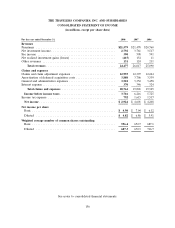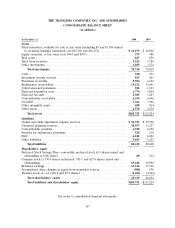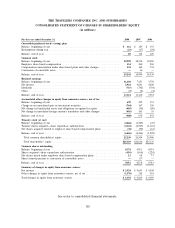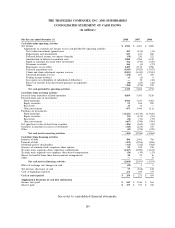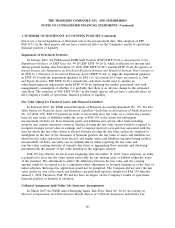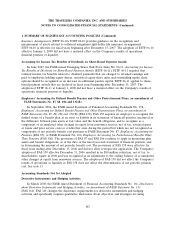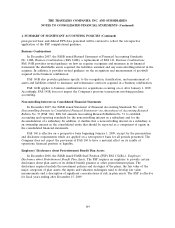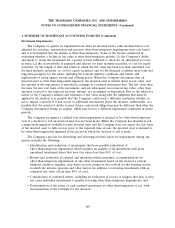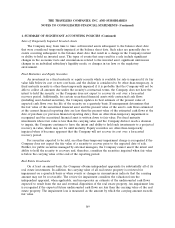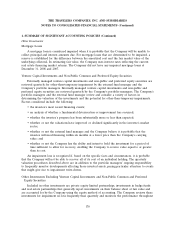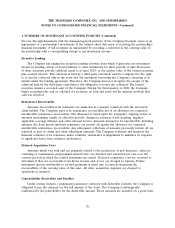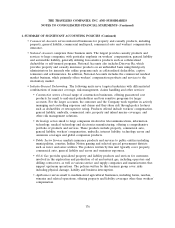Travelers 2008 Annual Report Download - page 178
Download and view the complete annual report
Please find page 178 of the 2008 Travelers annual report below. You can navigate through the pages in the report by either clicking on the pages listed below, or by using the keyword search tool below to find specific information within the annual report.THE TRAVELERS COMPANIES, INC. AND SUBSIDIARIES
NOTES TO CONSOLIDATED FINANCIAL STATEMENTS (Continued)
1. SUMMARY OF SIGNIFICANT ACCOUNTING POLICIES (Continued)
determined by the external fund manager and reviewed by the Company for investments in which there
is no public market.
In May 2007, the Company completed the bundled sale of a substantial portion of its venture
capital portfolio. Prior to the sale, these venture capital investments were consolidated in the
Company’s financial statements. As a result of the sale, the Company did not have any venture capital
investments that were consolidated at December 31, 2008 and 2007.
Other
Other investments include private equity limited partnerships, hedge funds, real estate
partnerships, joint ventures, non-public common and preferred equities, mortgage loans and trading
securities. The Company uses the equity method of accounting for private equity limited partnerships,
real estate partnerships, hedge funds and joint ventures. The partnerships and hedge funds generally
report investments on their balance sheet at fair value. The financial statements prepared by the
investee are received by the Company on a lag basis, with the lag period generally dependent upon the
type of underlying investments. The private equity partnerships and real estate partnerships provide
financial information quarterly which is generally available to investors, including the Company, within
three to six months following the date of the reporting period. The hedge funds provide financial
information monthly which is available to investors within one month following the date of the
reporting period. The Company regularly requests financial information from the partnerships prior to
the receipt of the partnerships’ financial statements, and records any material information obtained
from these requests in the financial statements. Mortgage loans are carried at amortized cost. Trading
securities are marked to market with the change in fair value recognized in net investment income
during the current period.
Derivative Financial Instruments
The Company may use derivative financial instruments, including interest rate swaps, foreign
currency forward contracts, equity swaps, credit derivatives, options, forward contracts and financial
futures, as a means of hedging exposure to interest rate, equity price change and foreign currency risk.
During 2008 and 2007, the Company used U.S. Treasury note futures to modify the duration of specific
assets within the investment portfolio and a foreign currency forward contract to hedge foreign
currency exposure of an investment in a foreign operation. The Company also held non-public stock
purchase warrants of a publicly-held company which are reported in other investments. For a further
discussion of the derivatives used by the Company, see note 3.
The Company’s insurance subsidiaries do not hold or issue derivative instruments for trading
purposes. The Company recognizes all derivatives, including certain derivative instruments embedded in
other contracts, as either assets or liabilities in the consolidated balance sheet and measures those
instruments at fair value. Where applicable, hedge accounting is used to account for derivatives. For an
instrument to qualify as a hedge, the hedge relationship must be designated and formally documented
at inception, detailing the particular risk management objective and strategy for the hedge, including
the item and risk that are being hedged, the derivative that is being used, and how effectiveness is
being assessed. A derivative must be highly effective in accomplishing the objective of offsetting either
changes in fair value or cash flows for the risk being hedged. The effectiveness of these hedging
relationships is evaluated on a retrospective and prospective basis using quantitative measures of
166


